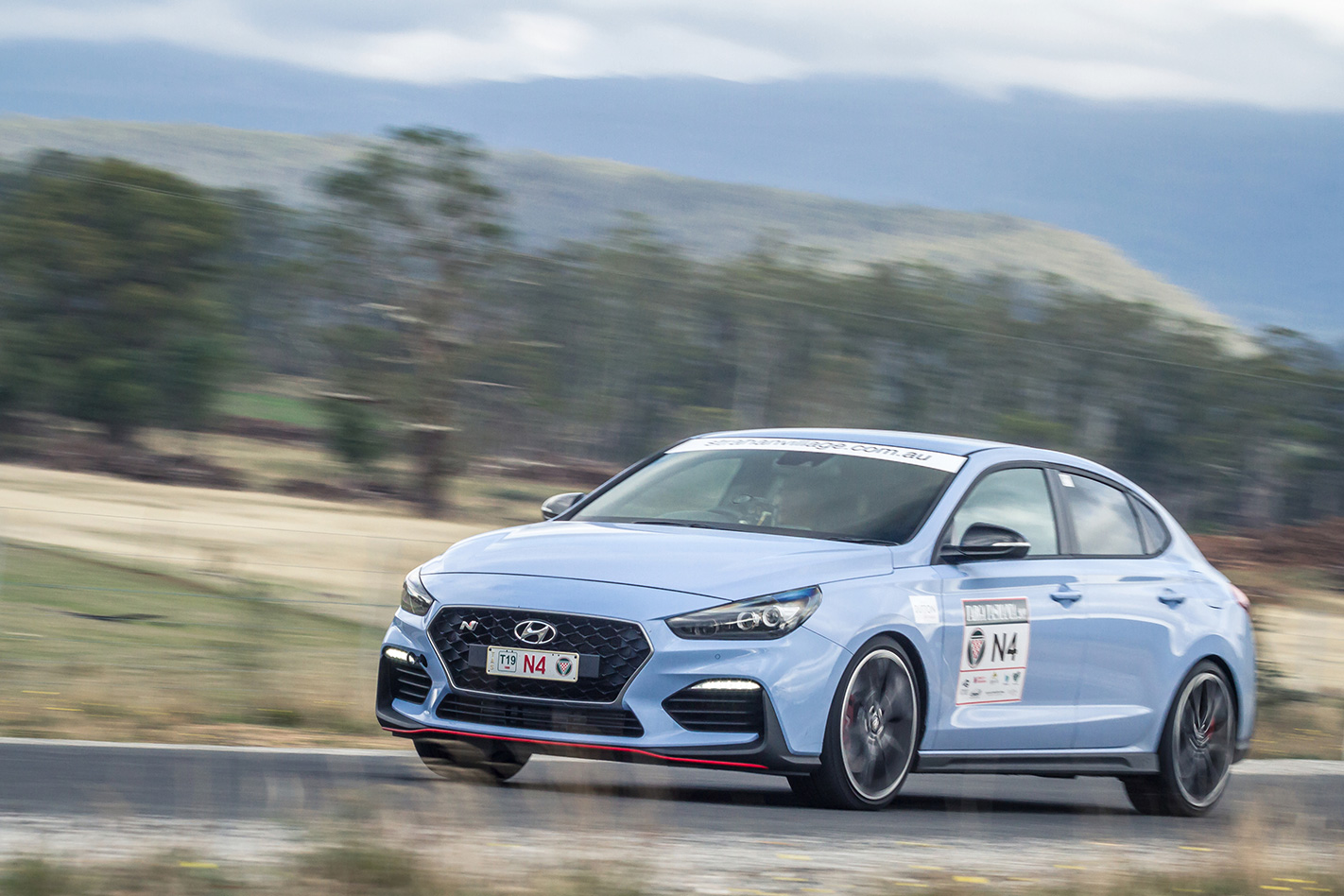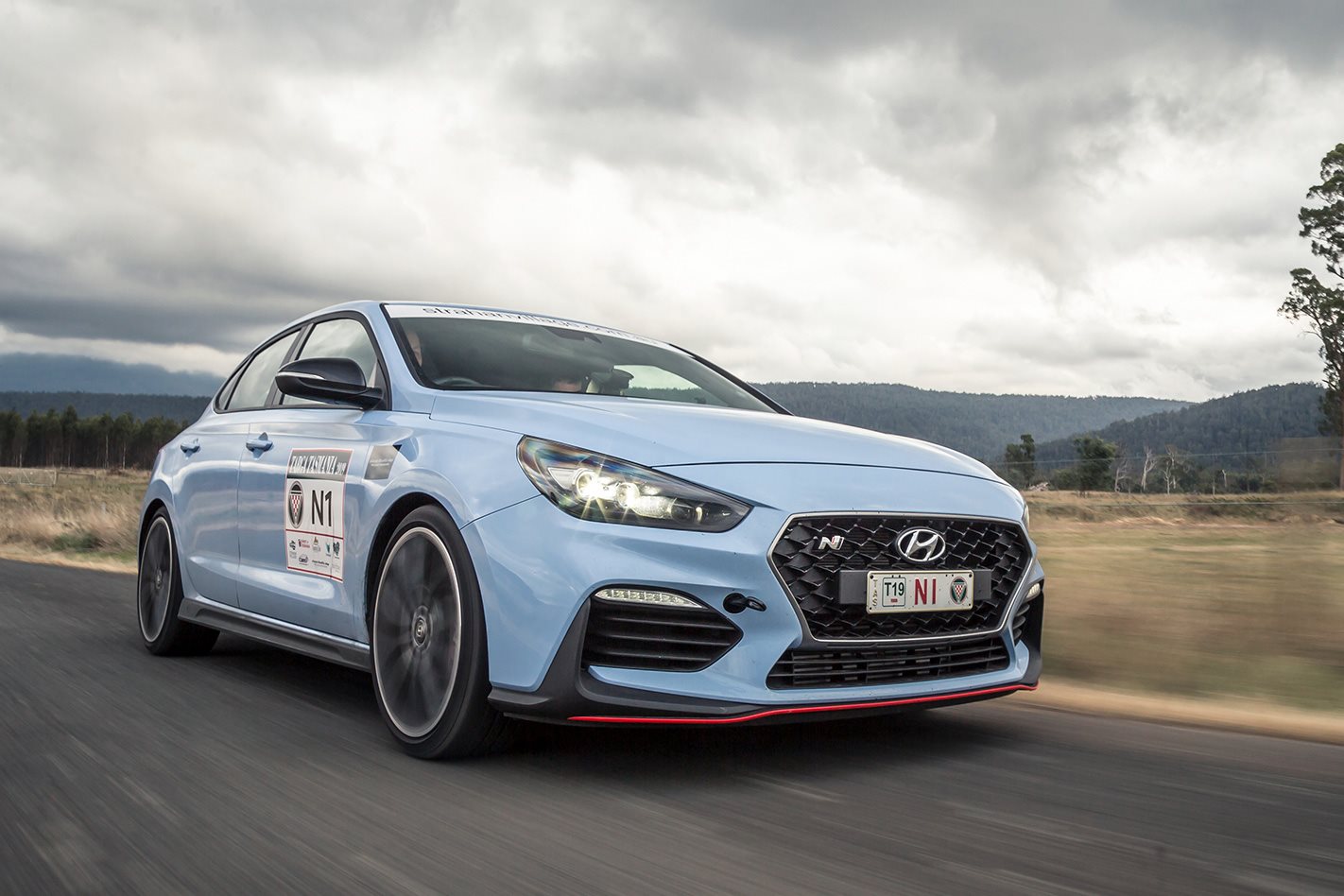THERE’S AN IDIOT filling my mirrors. He’s one of the high rollers at Launceston’s Country Club Casino and, as a result, he’s been comped a day in a Mercedes GLA in the Targa Tasmania Tour. Unfortunately, Pokie Champ hasn’t figured out that we’ve been limited to 120km/h for the event and seems to want to demonstrate that he’s the Tamar Valley’s answer to Sebastian Loeb. Right up to the moment he almost outbrakes himself and plants himself into the back of our Hyundai i30 N Fastback.

It’s not as if the Targa Tour isn’t exciting enough without a numpty who hasn’t read the rulebook inches from your back bumper on the straights. Yes, speeds may be capped at 120km/h and reported back to the clerks of the course by the unblinking eye of the GPS Rallysafe device that’s hardwired into your car, but the stages chosen by the organisers are often so tortuous that even the leading vehicles in the Targa proper, given free rein to lay into them at maximum attack, wouldn’t get close to that speed at 90 percent of the apexes.
With 202kW at your disposal in the i30 N, you’ve still got to exercise a fair degree of caution, especially as the road is frequently damp, greasy or covered in a mossy residue that has a Teflon-like coefficient of friction. The road book that the organisers have supplied doesn’t fill me with a great deal of confidence. An example: “straight on then 60m road goes left, deep culvert on left, – don’t cut this corner as this culvert will consume a vehicle”. Or there’s “EXTREME CAUTION road goes right, steep drop on left – this means what it says. Don’t get it wrong on this bend.”

Fortunately, we’ve got a very accomplished car for the task. You probably remember the Hyundai i30 N hatch blitzing all comers at Wheels’ Hot Hatch Megatest last year. This Fastback version is even better. Although the raked glasshouse styling is a little Marmite, we’re not complaining about the underpinnings. The 2.0-litre turbocharged engine is unchanged, but there’s been a lot of work refining the suspension.
In short, the Fastback gets a softer front anti-roll bar, and a lower front spring rate. This additional ‘give’ in the front suspension gives the Fastback better front-end bite than the hatch, allowing you to get the nose planted early and then, if you so desire, to enjoy a little more playfulness at the rear. It’s far from the soft option though. The bushes in part of the shock absorber and in some of the mounts have been sleeved for extra rigidity. There’s also a set of small helper springs at the top of the shock mounts that give it a bit more refinement at the extremes of travel, especially in rebound.

The rear is much the same as before, but a set of revised toe links and slightly firmer dampers have been added while leaving the spring rates as they were. The softer front sway bar has also necessitated a re-tune of the steering system. As well as the grippier front and more playful rear, Hyundai also claims that there are greater differences between the different drive modes the driver can access.
I’m thankful for all the front end grip I can get. The very first stage is quite an eye opener, Holwell being a flowing stage with many crests, some of which have fiendish bends following. I’ve got seven-time Australian-Pacific Rally Championship winner Cody Crocker in the jumpseat calling the notes. He’s beaten the likes of Richard Burns and Tommi Mäkinen on WRC stages, so I don’t feel pressured to try to impress him with my pedalling. The second stage is Kayena, another flowing road with a sharp climb to the finish.

The third stage is real fun. Although it’s a sprint at just 4.8km, the George Town stage runs through the closed streets of town, so apexing straight across blind corners, flying out of parking lots without checking left or right and leaping over roundabouts the wrong way feels like legalised getaway driving. I’d sign up for the Targa Tour just for this stage.
Day Two is when things get a bit more serious. The i30 N Fastback is a genuinely choice car for the event. It delivers power well on the treacherous bitumen, the ride isn’t so harsh that poor surfaces will really upset its composure, the steering’s excellent, the manual shift with rev matching is a gem and the brakes haven’t caught fire yet, which is a major bonus. I’m worrying if it’s a little too good. The perfect car might well have a little less power so that you feel as if you’re wringing its neck everywhere. Something like a Swift Sport or a 1.5-litre Mazda MX-5 might well be even more enjoyable. Still, I’m not complaining. Our strictly unofficial timing suggests that even with the 120km/h cap, we’re still quicker than many of the cars in the competitive Targa event.

We get the High Plains leg stretcher out of the way and then it’s into a real challenge. The Sheffield stage passes the Paradise Forest and it’s here that I have the biggest heart-in-mouth moment in the whole event when I turn into a sharp uphill right-hander, only to find it covered in green slime. Waiting for the front Pirelli P-Zeros to get some sort of purchase is agonising. The car skates towards a solid wall of rock for a split second before the stability control grabs at the brakes of the inside rear, and there’s enough yaw introduced to give the outside front tyre a chance. Crocker doesn’t say anything. I’m not too proud to admit that without the help of the Hyundai’s electronic stability control, we could well have been planted into the scenery.

After dispatching the Nook and Moriarty stages, we then dig in for three of Targa’s highlights. Ask a lot of veterans what their favourite stage is and many will answer ‘Paloona’. While Cethana is the one that attracts most of the headlines, Paloona might well be the connoisseur’s stage, just for its sheer variability and challenge. If you want to appreciate the speed at the pointy end of the field, just Google “Targa Tasmania 2019 Matt Close Paloona” and you’ll soon get the hang of things. While we’re not hitting 230km/h on the short straights like Mr Close, there are plenty of bends that allow zero margin for error.
Paloona is followed by Mt Rowland, another belter of a stage, effectively the first 26km of Cethana but in reverse. There are so many cautions on the pace notes for this stage that I take things a little easier. It’s not helped by the fact that Crocker, a lovely bloke and demon driver, admits he isn’t up to much as a navigator. “Road goes wiggly for the next few kilometres,” is probably not an instruction that Richard Burns would have had much time for.

Next up is Sideling. We’ve already seen a Porsche 911 Turbo smashed into a bank on the right-hand side of the road and this stage is renowned for drivers taking heavy cuts across the inside of the corners and spraying the tarmac with gravel. The other two drivers in my cohort have got their eye in and our tour leader, Chris Reeves, is pedalling the tyres off an i30 rental at the head of the field. Don’t worry about that 120km/h limit. Get in the right pack of cars on the tour and you’ll be driving some of Australia’s very best corners at flat chat.
I have a chat with Renato Loberto at lunch. He’s looking after the Ferrari team and has his hands full keeping some of the drivers on the straight and narrow. Three had spins at the same corner, one car was sent home at the end of day one for an egregious speeding offence on a transit stage, and of the 12 speeding offences reported to the clerks of the course on Day One, nine were from the Ferrari contingent. Given that there were nine Ferraris in the Tour group, that’s a 100 percent strike rate. It must be incredibly hard to keep to 120km/h in a 488 Pista though, so we have a measure of sympathy, albeit in a first-world problem kind of way.

We manage three days without a single speeding report, which pleases the organisers immensely. No crashes, no animals mown down, and no Mercedes GLAs planted into our rear ends – just – is a decent result. The third day sees race leader Steve Glenney extravagantly bin his Lotus Exige on the challenging Elephant Pass stage; just one of a number of high-profile offs in this event. A Lotus seems to be the right tool for the Targa proper this year, with Paul Stokell and Kate Catford taking out overall victory in an Exige Sport 350.
Hyundai rally ace Brendan Reeves and his co-driver Rhianon Gelsomino finish a very respectable fifteenth in their i30 N, registering a class victory in the process. Given that the next front-wheel-drive contender is almost an hour back and there’s a whole host of Lancer Evos, Porsche 911s, and Dodge Vipers in their wake, it’s one heck of an achievement.

We hand over our i30 N to the next journo team after three testing days. The Targa Tour, especially in suboptimal weather, is about the most intense driving activity I can think of that doesn’t require a helmet and roll cage. The Hyundai might not be quite the perfect car for the event. But it’s not far off.
HYUNDAI i30 N FASTBACK AUSTRALIA SPECS
Model: Hyundai i30 Fastback N Engine: 1998cc 4-cyl turbo, dohc, 16v Max power: 202kW @ 6000rpm Max torque: 353Nm @ 1450-4700rpm (overboost 378Nm @ 1750-4200rpm) Transmission: 6-speed manual, front-wheel drive Weight: From 1441kg (dry) 0-100km/h: 6.1 sec Economy: 6.9/100km Price: Sub $41,990 On sale: Now






